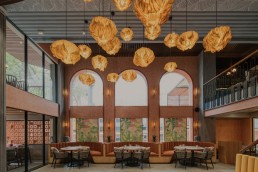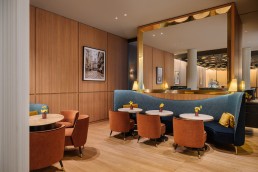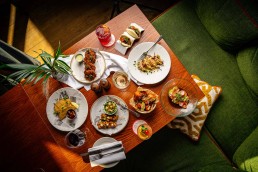LifeUp designs Bontadka restaurant at Luxant Hotel Bangalore
Bontadka, a casual fine dining restaurant designed by Gayatri Nhavkar and Gaurav Koshti of LifeUp Design Studio, is the new face of the recently renovated Luxant Hotel in Bangalore, India.
Named after the family behind it, the multi-cuisine restaurant draws inspiration from Anantharam Bontadka’s legacy, offering a setting where meals are meant to be savoured, not rushed.
While embracing the city’s scenic beauty, the design also incorporates vibrant elements envisioned by the client to inject energy into the space. It emphasises organic spatial flow, with elements inspired by natural forms and structures, and Art Deco undertones that echo this organic elegance.
The reimagined front façade of the hotel invites the soft glow of morning sunlight. A terracotta jali catches the eye from the street, offering filtered glimpses of the interiors as bougainvillea and creepers gently weave through it.
Though freshly planted, these climbers will gradually take root, and in time, the façade will come alive with vibrant blooms. At the hotel’s entrance, natural materials like terracotta blocks, cane lights, and stone plaster begin to emerge.
Inside, fluted concrete-finished columns rise through the space, complementing newly added arched fenestrations that frame views of the outdoors while bringing in soft natural light from the north. Tile inlays on the floor, floral designs hand-painted onto the ceiling, botanical paintings on the walls, and organic banana fibre lighting all reinforce the restaurant’s design narrative.
On the first floor, a cozy mezzanine creates a more intimate seating setting. A semi-covered outdoor seating area allows diners to enjoy the city’s pleasant climate, while the balcony offers a more elevated vantage point.
“The site naturally lent itself to creating different seating zones, shaped by the varying height,” explains Gayatri. “While it was a challenge to stitch these together cohesively, it also allowed for flexible seating arrangements that cater to a wide range of guests, ensuring adaptability in the dining experience.”

Beyond the ground floor, a newly added bridge connects the mezzanine on the left, previously home to the bar, to the once inaccessible balcony on the right. Moving past the bridge, the full mezzanine comes into view, centred around a metal tree-like structure that not only aligned with the restaurant’s theme but also created a sense of vertical expansion, counteracting the low height of the space.
The material palette here, much like the space below, is rich, warm, and vibrant, with earthy textures, bold patterns, and thoughtfully layered details that contribute to the overall spatial quality. Art Deco-inspired railings line the mezzanine, adding a layer of finesse.
The outdoor area is spread across two levels, one accessible from the lower level and the other through the bridge. Here, natural elements, from cane woven into the ceiling and lighting to the warm embrace of wood and the rawness of terracotta jali, create a blend of rustic and refined aesthetics.




